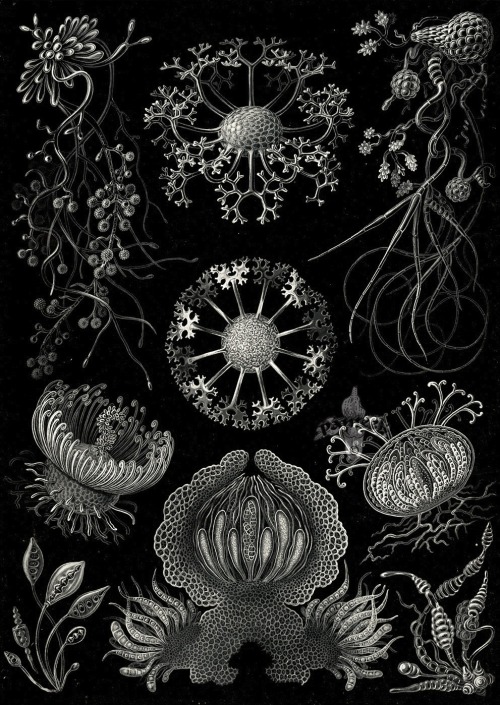In Slow Motion, Vortex Rings Can Be Truly Stunning. This Video Shows Two Bubble Rings Underwater As They

In slow motion, vortex rings can be truly stunning. This video shows two bubble rings underwater as they interact with one another. Upon approach, the two low-pressure vortex cores link up in what’s known as vortex reconnection. Note how the vortex rings split and reconnect in two places – not one. According to Helmholtz’s second theorem a vortex cannot end in a fluid–it must form a closed path (or end at a boundary); that’s why both sides come apart and together this way. After reconnection, waves ripple back and forth along the distorted vortex ring; these are known as Kelvin waves. Some of those perturbations bring two sides of the enlarged vortex ring too close to one another, causing a second vortex reconnection, which pinches off a smaller vortex ring. (Image source: A. Lawrence; submitted by Kam-Yung Soh)
Note: As with many viral images, locating a true source for this video is difficult. So far the closest to an original source I’ve found is the Instagram post linked above. If you know the original source, please let me know so that I can update the credit accordingly. Thanks!
More Posts from Hannahhaifisch and Others

#SCOPENewYork 2016 | Exhibitor Highlight | Nil Gallery - Booth B05
[Ardan Ozmenoglu, Olive Tree, 2008, paint on glass, 31 x 31 in.]
@ardanozmenoglu
Find out more at SCOPE-ART.COM


Photograph of the May 1919 solar eclipse captured by Arthur Eddington, which proved Einstein’s theory of general relativity.
Credit: SSPL/Getty Images









Ernst Haeckel. Hexacoralla, Ascomycetes, Lichenes, Phaeodaria, Ophiodea, Spumellaria, Basimycetes, Diatomea, Amphoridea. Kunstformen der Natur (Art Forms in Nature). 1899-1904.








Double triangle sawtooth by Miguel Angel Blanco Muñoz. I have liked how time seemed to slow down, folding the grid.

Researchers discover that chaos makes carbon materials lighter and stronger
In the quest for more efficient vehicles, engineers are using harder and lower-density carbon materials, such as carbon fibers, which can be manufactured sustainably by “baking” naturally occurring soft hydrocarbons in the absence of oxygen. However, the optimal “baking” temperature for these hardened, charcoal-like carbon materials remained a mystery since the 1950s when British scientist Rosalind Franklin, who is perhaps better known for providing critical evidence of DNA’s double helix structure, discovered how the carbon atoms in sugar, coal, and similar hydrocarbons, react to temperatures approaching 3,000 degrees Celsius (5,432 degrees Fahrenheit) in oxygen-free processing. Confusion over whether disorder makes these graphite-like materials stronger, or weaker, prevented identifying the ideal “baking” temperature for more than 40 years.
Fewer, more chaotically arranged carbon atoms produce higher-strength materials, MIT researchers report in the journal Carbon. They find a tangible link between the random ordering of carbon atoms within a phenol-formaldehyde resin, which was “baked” at high temperatures, and the strength and density of the resulting graphite-like carbon material. Phenol-formaldehyde resin is a hydrocarbon commonly known as “SU-8” in the electronics industry. Additionally, by comparing the performance of the “baked” carbon material, the MIT researchers identified a “sweet spot” manufacturing temperature: 1,000 C (1,832 F).
Read more.

0025

Native Gold with White Quartz
Eagle’s Nest Mine, Placer County, California

Watching the clouds go by on #Mars. Check out these atmospheric ripples!
-
 udulotaborkemencevel liked this · 6 months ago
udulotaborkemencevel liked this · 6 months ago -
 vald1n reblogged this · 6 months ago
vald1n reblogged this · 6 months ago -
 xmorcix liked this · 6 months ago
xmorcix liked this · 6 months ago -
 luxy-amigo liked this · 6 months ago
luxy-amigo liked this · 6 months ago -
 nyeznajka liked this · 6 months ago
nyeznajka liked this · 6 months ago -
 pajjorimre liked this · 6 months ago
pajjorimre liked this · 6 months ago -
 meginttuloktulok reblogged this · 6 months ago
meginttuloktulok reblogged this · 6 months ago -
 meginttuloktulok liked this · 6 months ago
meginttuloktulok liked this · 6 months ago -
 dulimano reblogged this · 6 months ago
dulimano reblogged this · 6 months ago -
 lassukmiboolelunk reblogged this · 6 months ago
lassukmiboolelunk reblogged this · 6 months ago -
 seantm liked this · 6 months ago
seantm liked this · 6 months ago -
 such-reblog reblogged this · 6 months ago
such-reblog reblogged this · 6 months ago -
 spirallyxstimmingxmermaid liked this · 6 months ago
spirallyxstimmingxmermaid liked this · 6 months ago -
 alienshifter reblogged this · 6 months ago
alienshifter reblogged this · 6 months ago -
 alienshifter liked this · 6 months ago
alienshifter liked this · 6 months ago -
 jamesmassino liked this · 6 months ago
jamesmassino liked this · 6 months ago -
 superdragonfireus liked this · 6 months ago
superdragonfireus liked this · 6 months ago -
 skredworks liked this · 6 months ago
skredworks liked this · 6 months ago -
 coopergriggs reblogged this · 6 months ago
coopergriggs reblogged this · 6 months ago -
 coopergriggs liked this · 6 months ago
coopergriggs liked this · 6 months ago -
 jdshepherd reblogged this · 6 months ago
jdshepherd reblogged this · 6 months ago -
 jdshepherd liked this · 6 months ago
jdshepherd liked this · 6 months ago -
 byenoonmoons reblogged this · 6 months ago
byenoonmoons reblogged this · 6 months ago -
 byenoonmoons liked this · 6 months ago
byenoonmoons liked this · 6 months ago -
 truthofthesignal reblogged this · 6 months ago
truthofthesignal reblogged this · 6 months ago -
 wetwicksdry liked this · 6 months ago
wetwicksdry liked this · 6 months ago -
 roguetelemetry reblogged this · 6 months ago
roguetelemetry reblogged this · 6 months ago -
 eclectichellmouth reblogged this · 1 year ago
eclectichellmouth reblogged this · 1 year ago -
 furrytreasurehunter liked this · 1 year ago
furrytreasurehunter liked this · 1 year ago -
 simply-pixeling liked this · 2 years ago
simply-pixeling liked this · 2 years ago -
 caveman-musings liked this · 3 years ago
caveman-musings liked this · 3 years ago -
 garamoba reblogged this · 3 years ago
garamoba reblogged this · 3 years ago -
 darncool reblogged this · 3 years ago
darncool reblogged this · 3 years ago -
 sashaexmachina liked this · 3 years ago
sashaexmachina liked this · 3 years ago -
 m00ndingochan reblogged this · 3 years ago
m00ndingochan reblogged this · 3 years ago -
 m00ndingochan liked this · 3 years ago
m00ndingochan liked this · 3 years ago -
 drummerofthought reblogged this · 3 years ago
drummerofthought reblogged this · 3 years ago -
 d--r--i--f--t--w--o--o--d reblogged this · 4 years ago
d--r--i--f--t--w--o--o--d reblogged this · 4 years ago -
 techjum reblogged this · 4 years ago
techjum reblogged this · 4 years ago -
 gagle liked this · 5 years ago
gagle liked this · 5 years ago -
 lawlkay liked this · 5 years ago
lawlkay liked this · 5 years ago -
 bewrabawa reblogged this · 5 years ago
bewrabawa reblogged this · 5 years ago -
 analysisrr liked this · 5 years ago
analysisrr liked this · 5 years ago -
 heartoftheempire reblogged this · 5 years ago
heartoftheempire reblogged this · 5 years ago -
 heartoftheempire liked this · 5 years ago
heartoftheempire liked this · 5 years ago